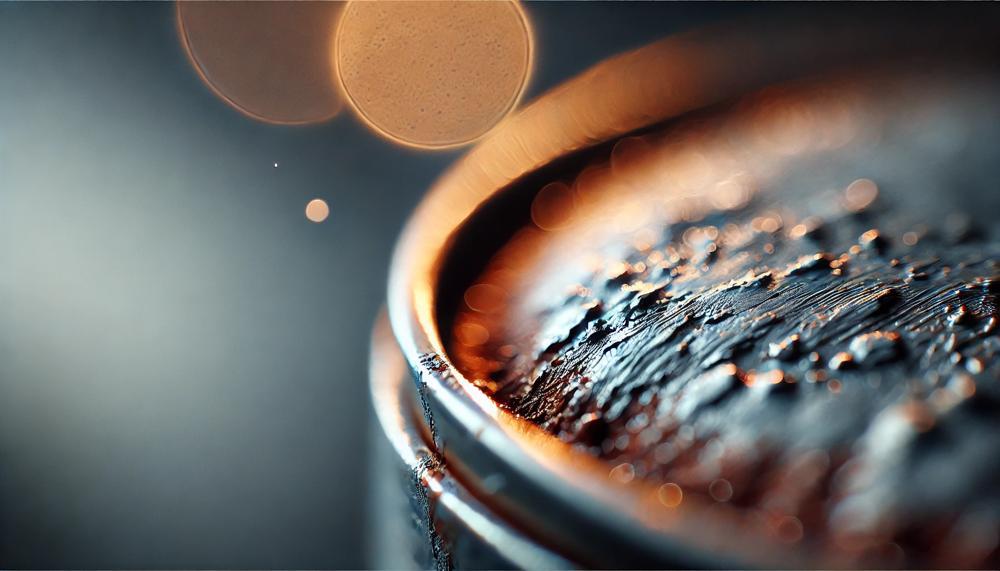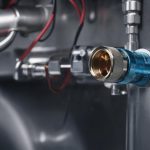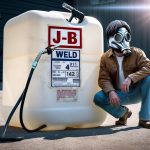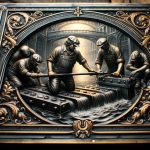Welding, the art of joining metals through heat and sometimes pressure, is a craft as old as metalwork itself. But what happens when modern complexities, such as painted surfaces, come into play? Can you weld painted metal? This question often stirs debates among professionals and hobbyists alike.
To cut through the noise, let’s dive straight into the heart of the matter: Yes, technically, you can weld painted metal, but it’s not as straightforward as welding bare metal. This article is your go-to guide for understanding the nuances and implications of welding over painted surfaces.
In this read, you’ll uncover a treasure trove of insights that will equip you with the knowledge to navigate this tricky aspect of welding. Here’s a sneak peek at what we’re unpacking:
- The challenges and risks associated with welding painted metal, including health hazards and potential impacts on weld quality.
- Preparation techniques for welding painted surfaces, ensuring the best possible outcome for your projects.
- Alternatives and best practices to consider if welding painted metal is unavoidable in your work.
Combining a casual tone with professional insights, this article aims to demystify the complexities surrounding the welding of painted metal. Whether you’re a seasoned welder or a curious enthusiast, you’re in for an informative journey that sheds light on a topic often shrouded in ambiguity. Let’s ignite our torches and explore the intriguing world of welding painted metal together.
Contents
Tip #1: Wear a Respirator
Wearing a respirator is crucial when welding painted metal due to the toxic fumes that can be released during the process. Paint, particularly older or lead-based varieties, can emit hazardous vapors when heated. These fumes pose significant health risks to welders, from respiratory issues to more severe conditions like metal fume fever or long-term neurological damage. A respirator effectively filters these harmful particles, ensuring the welder’s safety.
In the context of welding, where precision and safety are paramount, understanding the risks and protections is essential. Below is a breakdown of key points regarding the importance of respirators:
| Hazard | Risk | Prevention |
| Toxic Fumes | Respiratory issues, potential long-term health effects | Respirator usage |
| Lead Exposure | Neurological damage, metal fume fever | High-quality respirator, proper ventilation |
| Fire Hazard | Physical injury, property damage | Fire safety practices, cool surfaces post-welding |
Opting for a respirator not only shields the welder from immediate discomfort but also guards against the insidious build-up of toxins in the body. It’s a small step in the welding process with monumental benefits for health and safety.
Tip 2: Watch Out for Smoke
When torch meets painted metal, smoke is inevitable. This isn’t just any smoke, but a cocktail of hazards that can muck up the welding process and put your health on the line.
Let’s break it down, simple and straight, why this smoke is trouble and what you can do to steer clear of the mess.
Why Smoke is a Menace:
- Health Hazard: Welding painted surfaces isn’t a walk in the park. The heat transforms paint into a noxious fog of chemicals. Breathing this in is like inviting trouble for your lungs and body, leading to serious health issues down the road.
- Quality of Weld: Smoke isn’t just a health fiend; it’s also a quality thief. It can contaminate your weld, leading to weaker bonds. That’s the last thing you want when you’re looking for strength and durability in your welding projects.
- Visibility Issue: Ever tried working in a thick fog? That’s what welding smoke does. It clouds your vision, making it hard to see what you’re doing. This isn’t just annoying; it’s dangerous.
Battling the Smoke:
| Strategy | Description | Benefit |
| Remove Paint | Before striking an arc, grind off the paint from the area to be welded. | Reduces harmful smoke and improves weld quality. |
| Proper Ventilation | Work in a well-ventilated area or use extraction fans to suck away the smoke. | Keeps the air clear and reduces health risks. |
| Wear a Respirator | A high-quality respirator is a must to filter out harmful particles. | Protects your lungs from the toxic chemicals in the smoke. |
Stick Welding Works Best for Painted Materials
When you’re looking to fuse painted materials together, stick welding stands out as the ace in the pack. Here’s the lowdown on how it sizes up against its fellow welding methods:
| Welding Method | Key Features | Performance on Painted Materials |
|---|---|---|
| Stick Welding | Uses a consumable electrode and can handle impurities. | Top-notch; its high heat burns off impurities, making it ideal for painted surfaces. |
| MIG Welding | Utilizes inert gas to protect the weld; easier for novices. | Not bad, but the presence of paint can mess with the gas shield, leading to potential contaminants. |
| TIG Welding | Perfect for precision, uses a non-consumable tungsten electrode. | Struggles a bit. Paint needs removal for the clean, high-quality welds TIG is known for. |
Stick welding, with its rough-and-ready approach, doesn’t blink at painted or even slightly grimy surfaces. It’s like the tough old bird of the welding world, unfazed by dirt or paint. This method’s hearty appetite for heat chomps through impurities, leaving behind a solid join.
Meanwhile, the sleeker MIG and precise TIG methods prefer their metals clean-shaven, without the extra layers of paint that stick welding simply powers through.
So, if you’re tackling a project with painted materials and don’t fancy the prep work of scraping and cleaning, stick welding’s your ticket.
Strike an Arc with the Metal Surface

Striking an arc directly onto a painted metal surface plays a pivotal role in the welding process, dramatically impacting the efficacy and safety of the bond. Here’s a dive into how it influences the welding journey:
| Impact on Weld Quality | Safety Considerations | Preparation Necessity |
| Initially, striking an arc burns through the paint, creating a crucial area of bare metal essential for welding. This ‘burn off’ phase is critical; if not properly managed, it can lead to weak welds marred by porosity due to paint contaminating the weld pool. | Paint, especially if laden with metals like zinc or lead, releases toxic fumes under the heat of the arc. These fumes pose significant health hazards, necessitating careful attention to ventilation and protective gear during welding. | Pre-welding prep involves stripping the paint near the weld area using a grinder or wire brush, followed by cleaning with a degreaser. This step is crucial to remove any residue that could impair weld integrity or generate harmful fumes. |
| For painted surfaces, stick welding shines by effectively burning away impurities, creating strong bonds where MIG and TIG may falter due to their preference for cleaner surfaces. | Choosing the right paint, like water-based options, can mitigate health risks since they are less likely to produce hazardous fumes compared to oil-based alternatives. | After removing the paint, it’s important to apply a water-based paint or primer for future welds. These are easier to remove and safer when heated, ensuring a cleaner, safer weld area. |
In essence, the act of striking an arc against a painted surface demands a keen awareness of the challenges and risks involved. By taking appropriate preparatory steps and understanding the nuances of the welding process, welders can ensure a safe environment and achieve welds of high integrity and strength.
Try to Contain the Damage
When tackling the challenge of welding painted metal, the primary goal is to mitigate harm while preserving the integrity of both the workpiece and the welder’s health. Below are detailed strategies and considerations to minimize damage during this tricky process.
Health and Safety Precautions
- Ventilation is Key: Ensure you’re working in a well-ventilated area to prevent inhaling toxic fumes from burning paint.
- Use a Respirator: Don a high-quality respirator to shield yourself from hazardous gases.
Optimal Welding Practices
- Grind Strategically: While completely removing paint is ideal, if it’s not feasible, grind away paint at least in the area of welding to reduce contamination.
- Choose Stick Welding: This method is adept at burning through paint, making it a preferred choice for such tasks.
Technical Insights for Welding on Painted Metal
| Aspect | Detail | Rationale |
| Preferred Electrodes | 6010 or 6011 rods | They offer deep penetration and aid in achieving clean welds on painted surfaces. |
| Initial Preparation | Grind off paint for electrode contact | Ensures effective arc striking and reduces impurities. |
| Post-Welding | Check for and extinguish fires | Minimizes risk of fire hazards due to flammable paint vapors. |
Minimizing Weld Defects
- Monitor Temperature: Maintain appropriate heat levels to prevent excessive paint burning and reduce toxic fume generation.
- Post-Weld Cleaning: After welding, clean the area to remove any residual paint or slag, ensuring a robust and clean joint.
By heeding these guidelines, welders can significantly lessen the damage inflicted when welding painted metal.
Choose the Right Rod for the Job
When tackling the task of welding on painted metal, the key is not just about getting the job done but doing it right, safely, and efficiently.
Choose the Right Rod for the Job, steers us into the art and science of selecting the ideal welding rod, which becomes even more pivotal when facing painted surfaces.
Understanding the Challenge
Paint on metal is not merely an aesthetic layer; it’s a barrier that complicates welding processes. The presence of paint, especially types with lead or zinc, elevates the risk of hazardous fume release and necessitates extra precautions, like enhanced ventilation and the use of respirators.
Beyond health concerns, paint burns produce dense smoke, impairing visibility and the weld’s integrity.
Selecting the Rod
For those instances where paint removal isn’t feasible and welding must proceed, the choice of rod is paramount. Here’s a rundown on the go-to options:
| Rod Type | Features | Why It Works for Painted Metal |
| 6010 | Deep penetration, fast freeze | Its ability to cut through contaminants makes it suitable for painted surfaces. |
| 6011 | Deep penetration, all positions, AC and DC | Flexibility and deep penetration help manage the paint barrier effectively. |
Safety First
Prioritising safety, it’s a must to remove as much paint as possible before starting—resorting to sanding or grinding to diminish potential risks.
Also, bear in mind the necessity of checking for potential fire hazards post-welding, given the flammable nature of paint.
The Bottom Line
While the 6010 and 6011 rods stand out for their adaptability and performance on painted metals, the golden rule remains: whenever possible, strip the metal of paint before welding. This strategy ensures the safety of the welder and the integrity of the weld.
Watch out for Fire
Welding painted metal isn’t a walk in the park. It’s a bit like dancing on a tightrope—you’ve got to balance skill with serious caution. Here’s the skinny on keeping those flames at bay:
- Strip Away the Paint: Ideally, get rid of that old paint. Paint and flames are like oil and water—they don’t mix. If the paint’s gotta stay, keep reading.
- Suit Up Right: Don your respirator, mate. Those fumes aren’t your friends. Also, slap on fire-resistant gear. It’s better to sweat than to sizzle.
- Choose Your Battlefield: Weld outdoors if you can. Fresh air is a gem. Stuck inside? Make sure that area’s ventilated like it’s a breezy beach hut.
- Stick to Stick Welding: Sounds catchy, right? Use stick welding—6010 or 6011 rods are your best pals here. They slice through that pesky paint like a hot knife through butter.
- Mind the Gap: Grind a wee bit of paint off where your weld’s gonna be. Think of it as clearing the stage before the main act.
- Fire Watch: Finished welding? Don’t just wander off. Stick around and keep an eye out for smoulders or flames. Your work’s not done until you know there’s no fire risk.
Safety Measures Table:
| Action | Reason | Benefit |
| Remove Paint | Prevents toxic fumes and fire risks. | Healthier, safer welding environment. |
| Wear Protective Gear | Blocks harmful gases and prevents burns. | Enhanced safety and fewer health risks. |
| Ensure Ventilation | Reduces gas concentration. | Lower risk of fire and health hazards. |
| Select Proper Welding Rod | Improves weld quality on painted surfaces. | Stronger, safer welds. |
| Monitor After Welding | Prevents unnoticed fire outbreaks. | Peace of mind and safety after the job. |
Remove Paint, If You Can
Removing paint from metal prior to welding is more than just a step in the process; it’s a stride towards excellence in your work. Let’s delve into the why and how, making sense of this crucial practice with simplicity and clarity.
Why Remove Paint?
| Ensures Strong Welds | Paint acts as a barrier between metals, preventing the weld from taking hold as it should. Clean metal surfaces fuse better. |
| Prevents Defects | Welding over paint can lead to impurities in the weld, causing weaknesses that might not be visible immediately but could lead to failure over time. |
| Avoids Toxic Fumes | Heating paint can release harmful fumes. Removing paint beforehand keeps the air clear and the welder safe. |
| Enhances Aesthetic Finish | A clean weld on bare metal is not only stronger but also looks neater and more professional than one done over paint. |
| Prepares for Post-Welding Treatments | Clean welding surfaces are essential for any treatments or painting after welding, ensuring better adhesion and longevity. |
How to Remove Paint
The task of removing paint is not one to shy away from. With the right tools and a bit of elbow grease, you can prepare your metal for a pristine weld. Using a wire brush is a favoured method, effectively scraping away not just paint but also rust and other contaminants.
Sandpaper or a grinding disc can get the job done too, especially for those stubborn spots.
And let’s not forget about chemical cleaners — they can strip paint without much physical effort, though they require proper handling and safety measures.
Clean Both Sides
Remember, it’s not just the side you’re welding on that needs attention. The flip side matters too. Contaminants can lurk and leap into your weld from beneath, so giving both sides a thorough clean is a sterling strategy.
Conclusion
Welding painted metal emerges as a nuanced art form, bridging tradition with the modern intricacy of painted surfaces.
This craft demands not only technical prowess but also a vigilant approach to safety and preparation. At the heart of welding over paint lies the imperative to achieve a clean, contaminant-free metal surface.
This foundational step is crucial not just for the integrity of the weld but also for the health of the welder, given the hazardous fumes released from burning paint. Stick welding, with its robust capability to power through impurities, is championed as the go-to technique for tackling the unique challenges painted surfaces present.
Our exploration underscores a trifecta of paramount considerations: meticulous surface preparation, the strategic selection of welding techniques and equipment, and unwavering attention to health and safety protocols. By adhering to these principles, welders can navigate the complexities of welding painted metal with finesse and assurance.
This guide serves as a beacon for both seasoned welders and novices, illuminating the path to mastering the delicate balance between achieving durable welds and preserving well-being.





